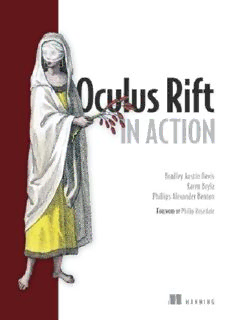
Oculus Rift in Action PDF
Preview Oculus Rift in Action
Oculus Rift in Action Bradley Austin Davis, Karen Bryla, and Phillips Alexander Benton Copyright For online information and ordering of this and other Manning books, please visit www.manning.com. The publisher offers discounts on this book when ordered in quantity. For more information, please contact Special Sales Department Manning Publications Co. 20 Baldwin Road PO Box 761 Shelter Island, NY 11964 Email: [email protected] ©2015 by Manning Publications Co. All rights reserved. No part of this publication may be reproduced, stored in a retrieval system, or transmitted, in any form or by means electronic, mechanical, photocopying, or otherwise, without prior written permission of the publisher. Many of the designations used by manufacturers and sellers to distinguish their products are claimed as trademarks. Where those designations appear in the book, and Manning Publications was aware of a trademark claim, the designations have been printed in initial caps or all caps. Recognizing the importance of preserving what has been written, it is Manning’s policy to have the books we publish printed on acid-free paper, and we exert our best efforts to that end. Recognizing also our responsibility to conserve the resources of our planet, Manning books are printed on paper that is at least 15 percent recycled and processed without the use of elemental chlorine. Manning Publications Co. Development editor: Dan Maharry 20 Baldwin Road Technical development editor Justin Chase PO Box 761 Copyeditor: Liz Welch Shelter Island, NY 11964 Proofreader: Elizabeth Martin Technical proofreader: Frederik Vanhoutte Typesetter: Dennis Dalinnik Cover designer: Marija Tudor ISBN 9781617292194 Printed in the United States of America 1 2 3 4 5 6 7 8 9 10 – EBM – 20 19 18 17 16 15 Dedication For Leo and Kesten B.D. For Sam, Ted, and Max K.B. For Antonia A.B. Brief Table of Contents Copyright Brief Table of Contents Table of Contents Foreword Preface Acknowledgments About this Book About the Authors Author Online About the Cover Illustration 1. Getting started Chapter 1. Meet the Oculus Rift 2. Using the Oculus C API Chapter 2. Creating your first Rift interactions Chapter 3. Pulling data out of the Rift: working with the head tracker Chapter 4. Sending output to the Rift: working with the display Chapter 5. Putting it all together: integrating head tracking and 3D rendering Chapter 6. Performance and quality 3. Using Unity Chapter 7. Unity: creating applications that run on the Rift Chapter 8. Unity: tailoring your application for the Rift 4. The VR user experience Chapter 9. UI design for VR Chapter 10. Reducing motion sickness and discomfort 5. Advanced Rift integrations Chapter 11. Using the Rift with Java and Python Chapter 12. Case study: a VR shader editor Chapter 13. Augmenting virtual reality Appendix A. Setting up the Rift in a development environment Appendix B. Mathematics and software patterns for 3D graphics Appendix C. Suggested books and resources D. Glossary Index List of Figures List of Tables List of Listings Table of Contents Copyright Brief Table of Contents Table of Contents Foreword Preface Acknowledgments About this Book About the Authors Author Online About the Cover Illustration 1. Getting started Chapter 1. Meet the Oculus Rift 1.1. Why support the Rift? 1.1.1. The call of virtual reality 1.1.2. But what about the Rift? 1.2. How is the Rift being used today? 1.3. Get to know the Rift hardware 1.3.1. The DK2 1.3.2. The DK1 1.3.3. The GPU 1.4. How the Rift works Conventional applications Rift applications 1.4.1. Using head tracking to change the point of view 1.4.2. Rendering an immersive view 1.5. Setting up the Rift for development 1.6. Dealing with motion sickness 1.7. Development paths 1.8. Summary 2. Using the Oculus C API Chapter 2. Creating your first Rift interactions 2.1. SDK interfaces 2.1.1. Oculus runtime 2.1.2. Oculus SDK 2.2. Working with the SDK 2.2.1. SDK management 2.2.2. Managing the HMD 2.3. Getting input from the head tracker 2.3.1. Reserving a pointer to the device manager and locating the headset 2.3.2. Fetching tracker data 2.3.3. Reporting tracker data to the console 2.3.4. Exiting and cleaning up 2.3.5. Understanding the output 2.4. A framework for demo code: the GlfwApp base class 2.5. Rendering output to the display 2.5.1. The constructor: accessing the Rift 2.5.2. Creating the OpenGL window 2.5.3. Rendering two rectangles, one for each eye 2.6. What’s next? 2.7. Summary Chapter 3. Pulling data out of the Rift: working with the head tracker 3.1. The head tracker API 3.1.1. Enabling and resetting head tracking 3.1.2. Receiving head tracker data 3.2. Receiving and applying the tracker data: an example 3.2.1. Initial setup and binding 3.2.2. Fetching orientation 3.2.3. Applying the orientation to the rendered scene 3.3. Additional features: drift correction and prediction 3.3.1. Drift correction 3.3.2. Prediction 3.3.3. Using drift correction and prediction 3.4. Summary Chapter 4. Sending output to the Rift: working with the display 4.1. Targeting the Rift display 4.1.1. Extended vs. Direct HMD mode 4.1.2. Creating the OpenGL window: choosing the display mode 4.1.3. Creating the OpenGL window: Extended Desktop mode 4.1.4. Creating the OpenGL window: Direct HMD mode 4.1.5. Full screen vs. windowed: extensions with glfwCreateWindow() 4.1.6. Dispensing with the boilerplate
Description: